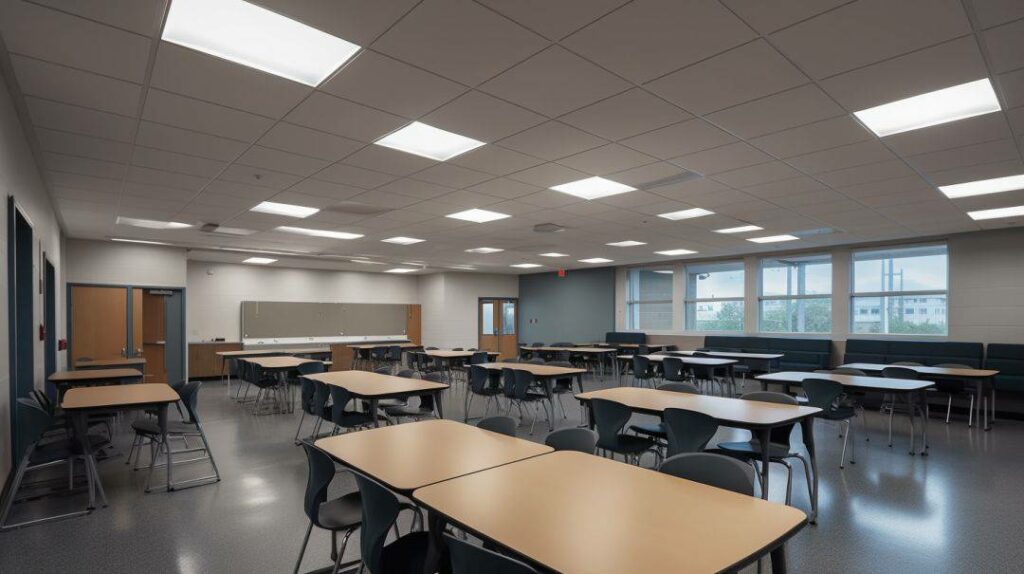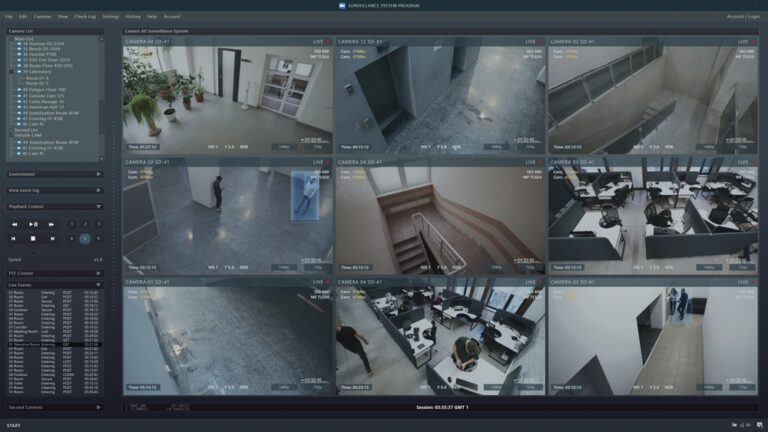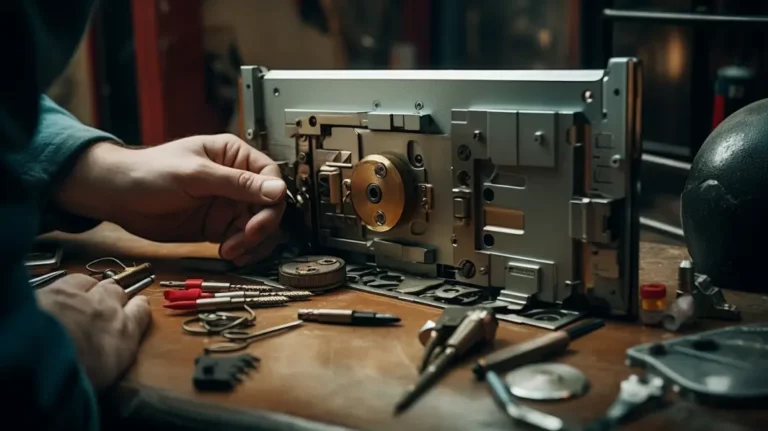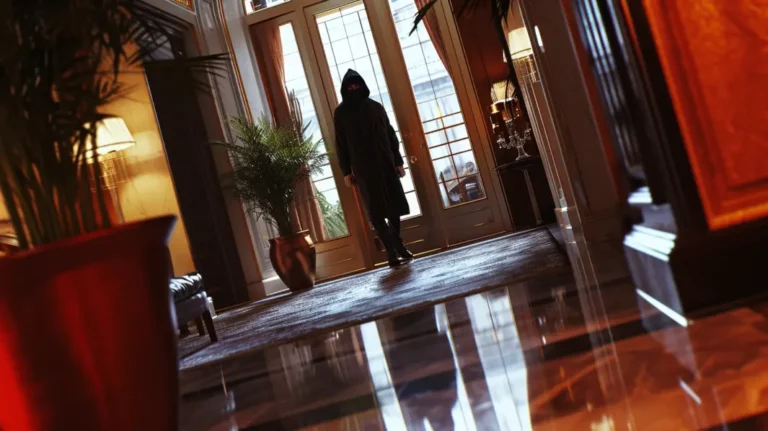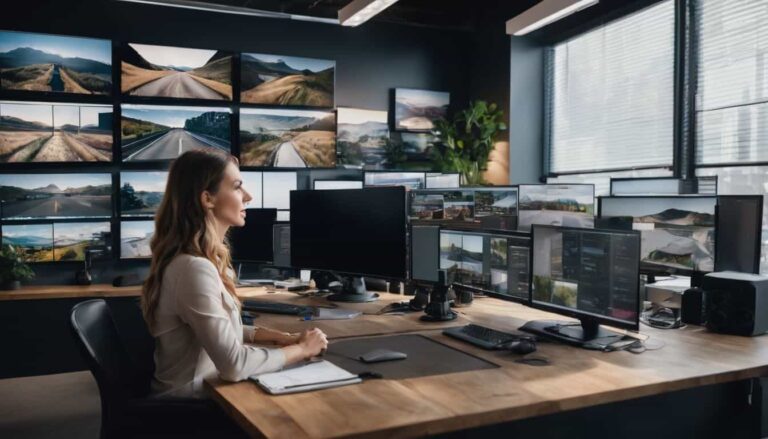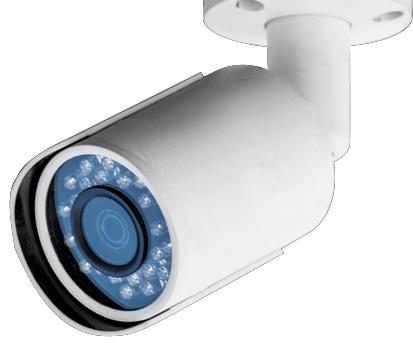-
1)
Introduction
- 1.1) The Importance of Security Cameras for Educational Institutions
- 1.2) Types of Security Cameras for Schools
- 1.3) Benefits of Using CCTV Systems in Schools
- 1.4) Challenges and Concerns of Using Security Cameras in Schools
- 1.5) Best Practices for Implementing Security Cameras in Schools
-
1.6)
Innovative Uses of Security Cameras for Schools
- 1.6.1) Monitoring Social Distancing and Crowd Control
- 1.6.2) Tracking School Buses and Bus Stops
- 1.6.3) Monitoring Access to Restricted Areas
- 1.6.4) Enhancing Fire Safety with Addressable Alarm Systems
- 1.6.5) Improving Campus Security with Access Control
- 1.6.6) Analytics for People Counting, Dwell Time Monitoring
- 1.6.7) License Plate Recognition at Parking Lots
- 1.6.8) Artificial Intelligence to Detect Weapons or Threats
- 1.7) How Schools Can Benefit from Upgrading to Modern Security Cameras
- 1.8) Case Studies: School Districts Using Verkada Security Cameras
- 1.9) Conclusion: Why Schools Should Consider Utilizing Security Cameras
-
1.10)
FAQs
- 1.10.1) What types of security cameras are best for schools?
- 1.10.2) Where should security cameras be installed in schools?
- 1.10.3) How does video surveillance improve school security?
- 1.10.4) What are some innovative uses for security cameras in education?
- 1.10.5) How can schools balance student privacy with security cameras?
Educational institutions have a responsibility to provide a safe and secure learning environment for students and staff. As threats to school safety continue to be a concern, more K-12 schools, colleges and universities are turning to security cameras as part of their overall security strategy.
| Key Takeaways on Using Security Cameras in Schools |
|---|
| Properly utilized CCTV systems greatly enhance campus safety and security. |
| Address valid privacy concerns through careful camera placement and responsible policies. |
| Select appropriate camera types based on visibility needs and environment. |
| Train personnel on proper monitoring, intervention protocols, and compliance. |
| Leverage innovative camera capabilities like analytics for new applications. |
Introduction
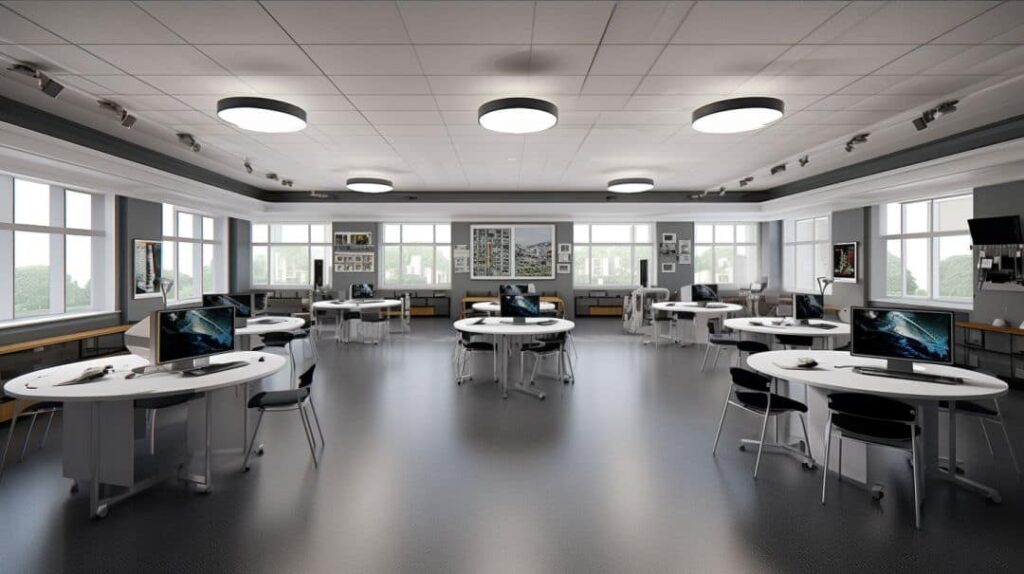
Security cameras offer significant benefits for monitoring activity, enhancing situational awareness, and investigating incidents if they occur. However, implementing security cameras in schools also raises important considerations around student privacy, public perception, proper use of footage, and overall effectiveness.
In this comprehensive guide, we will explore the importance of security cameras for schools, types of cameras available, benefits and challenges of using CCTV systems, best practices for implementation, and innovative ways cameras can enhance school safety and security.
With the right policies and procedures in place, security camera systems can be an extremely valuable tool for creating a safe, welcoming, and positive learning environment. By understanding key factors like placement, camera types, and community engagement, education leaders can thoughtfully adopt security technologies as part of a holistic approach to campus safety.
The Importance of Security Cameras for Educational Institutions
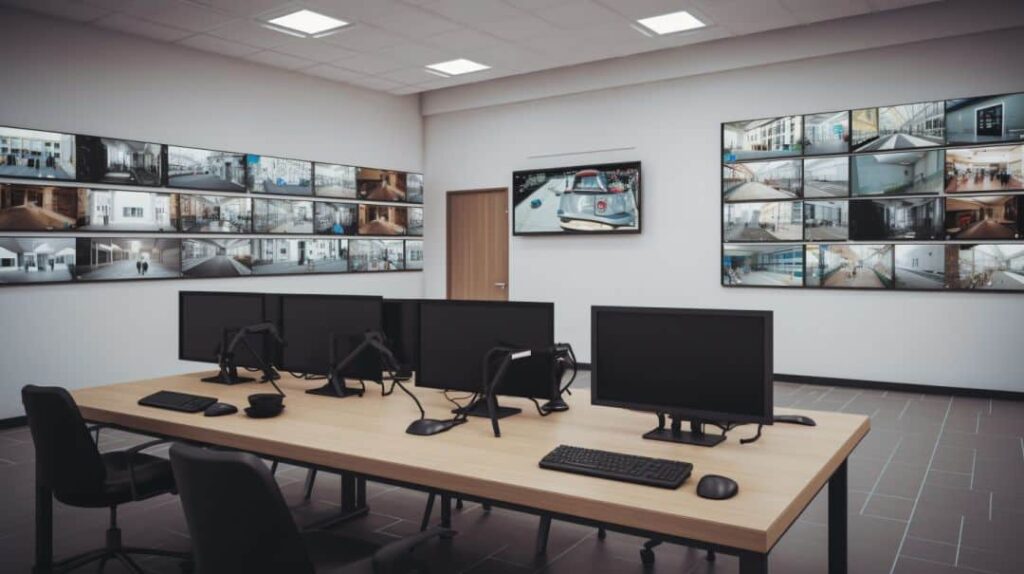
School safety continues to be a top concern for parents, students, teachers, administrators, and communities. Security cameras have become an increasingly common part of comprehensive strategies to enhance protection and awareness across school campuses. There are several key reasons CCTV systems are vital for modern educational institutions:
Protecting Students and Faculty
The core priority of any school is to provide a safe environment conducive to learning and development. Security cameras help achieve this by providing oversight of activities and tracking potential threats or unauthorized individuals. Camera systems allow security personnel and administrators to monitor areas in real-time and respond quickly to concerning situations.
Deterrent for Potential Threats
Visible security cameras can also serve as an effective deterrent to would-be assailants or trespassers. Signage alerting that CCTV surveillance is in use demonstrates that extra measures are in place to identify suspicious behavior and prevent incidents. The presence of cameras throughout a campus makes it less likely that crimes or policy violations will be attempted.
Assist in Quick Incident Resolution
When serious incidents do occur at schools, security camera footage provides vital evidence to aid investigations. Footage can help authorities and school officials reconstruct events, identify involved parties, establish timelines, and take appropriate disciplinary or legal action. This not only assists in resolving the immediate incident, but camera evidence helps prevent future recurrences.
Types of Security Cameras for Schools
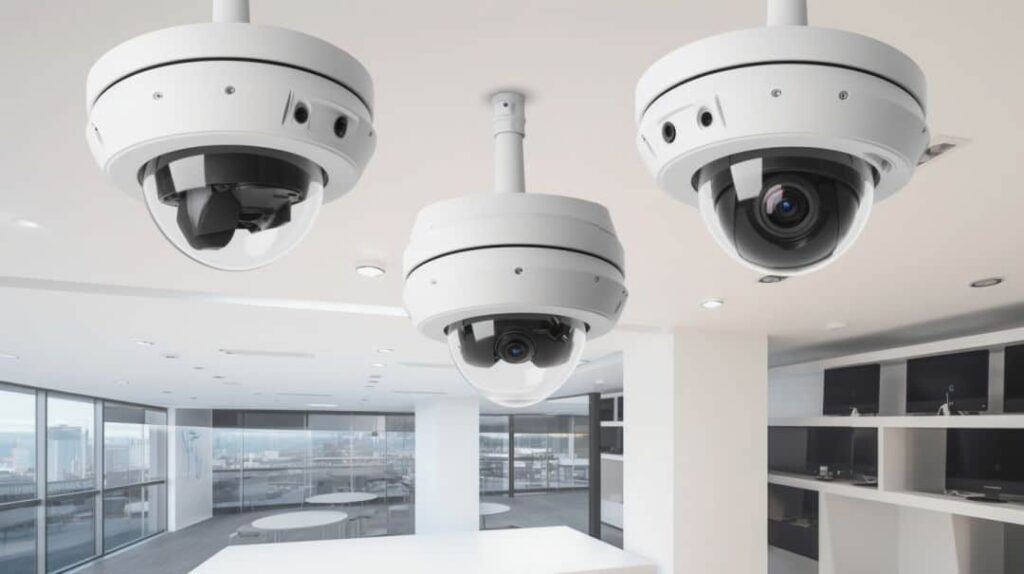
Educational institutions have a wide variety of options when selecting security cameras to install across their campuses. Key factors to consider include visibility, vandal resistance, video quality, and ease of installation. Here are some of the most common camera types used in school security systems:
Bullet Cameras
Bullet cameras are aptly named for their long cylindrical shape. They are highly versatile and can provide great image quality even in low light conditions. Bullet cams are easy to mount on walls or ceilings and their compact size makes them discreet.
Dome Cameras
Dome cameras get their name from their dome-like exterior housing. They offer a sleek, unobtrusive appearance and their encasement protects them against vandalism or tampering. Many feature pan/tilt/zoom functionality.
PTZ Cameras
PTZ (pan/tilt/zoom) cameras allow operators to remotely control the position and magnification of the camera. This allows a single PTZ camera to cover a wide area and provides the flexibility to closely monitor people or areas of interest.
Addressable Fire Alarm Systems
Addressable fire alarms integrate with security cameras to pinpoint the exact location of triggered alarms. This helps accelerate emergency response and allows staff to quickly assess potential fires via live footage.
Benefits of Using CCTV Systems in Schools
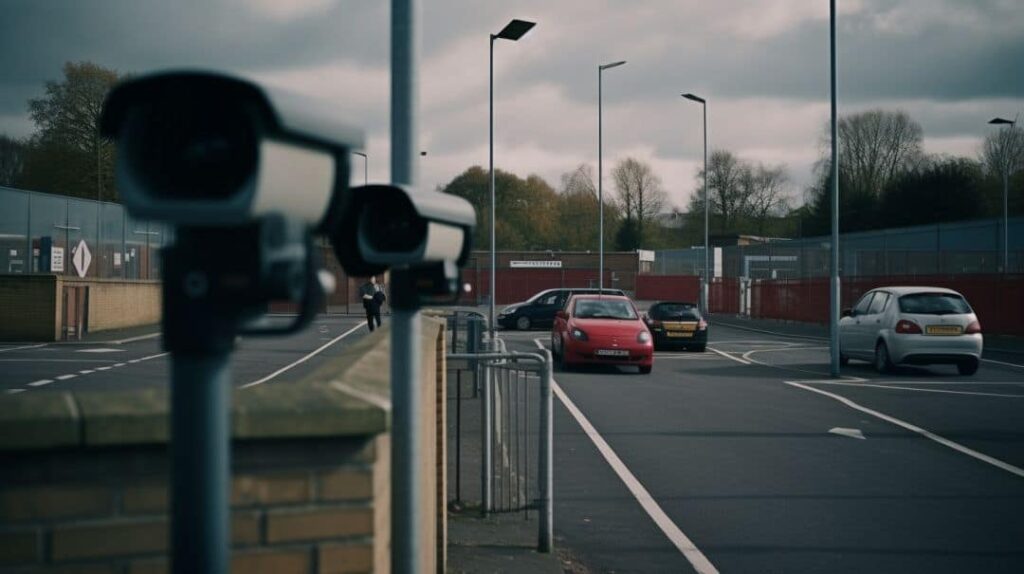
Implementing a comprehensive CCTV security camera system offers numerous advantages that support the safety, security, and operational efficiency of educational institutions both large and small. The benefits of modern network-based camera systems include:
Improved Safety and Security
The primary benefit of security cameras at schools is enhanced safety and security across the campus. CCTV systems act as an extra set of eyes, providing 24/7 monitoring of activities in classrooms, hallways, cafeterias, parking lots, and other campus areas. School security personnel can keep a close eye on the video feeds to look out for any suspicious individuals or activities that may pose a risk to students and faculty. The cameras serve as a force multiplier, allowing a handful of security guards to monitor a large facility.
With proper placement of cameras, there are few blind spots across the campus, giving security staff advance warning of potential disturbances or criminal behavior. The cameras can detect threats or policy violations early on, allowing for a rapid targeted response to prevent further escalation. Students and teachers can feel more at ease knowing that any emergencies will be visually detected and dealt with quickly.
Quick Access to Live Feeds
Another major advantage of networked IP-based CCTV systems is the ability for authorized personnel to instantly access live feeds on their computers or smartphones. When incidents occur, the principal, security team, and other designated staff can immediately pull up the relevant camera feeds on their devices to monitor the situation as it unfolds.
This real-time visibility facilitates rapid and informed decision making in response to any fights, medical emergencies, natural disasters or criminal acts. School officials can continue monitoring the situation remotely while coordinating the appropriate emergency response.
Scalability for Large Institutions
Educational institutions with large, sprawling campuses and tens of thousands of students require easily scalable camera systems. Networked IP cameras make it simple to gradually expand the system by just adding additional cameras as needs evolve across multiple buildings and facilities.
Unlike analog systems, IP cameras do not require running video cabling back to a central DVR location. Instead, each camera simply needs a PoE (power over Ethernet) network connection to plug into the existing IP network. This makes installation much faster and more cost effective. Additional servers or storage can be added incrementally to support more cameras and footage.
Centralized Management
Modern CCTV camera systems allow very convenient centralized management of the entire system from any web browser. School IT and security departments can access a unified dashboard to monitor the status of all cameras, set user permissions, ingest and retrieve footage, receive health alerts, and configure system settings. There is no need to physically interact with locally installed DVRs.
Centralized management vastly simplifies the administration of large camera networks with hundreds of cameras across multiple sites. It also makes it easy to provide tiered access to live and recorded footage to different authorized user groups such as campus security, senior administration, and local law enforcement.
Monitor System Health
Robust CCTV management software tracks the online/offline status of cameras and can alert technicians to any technical issues requiring maintenance, such as disabled cameras or storage failures. This allows problems to be promptly detected and corrected to minimize downtime of critical security systems. Technicians can also access detailed camera diagnostics to remotely troubleshoot and optimize performance.
High Return on Investment
For the comprehensive protection and situational awareness they provide across sprawling campuses, CCTV security systems deliver a very high return on investment compared to the total cost of installation, operation and monitoring. When appropriately utilized, CCTV systems reduce incident response times and deter criminal behavior, paying for themselves many times over by enhancing safety as well as guarding against liability and property losses.
Challenges and Concerns of Using Security Cameras in Schools
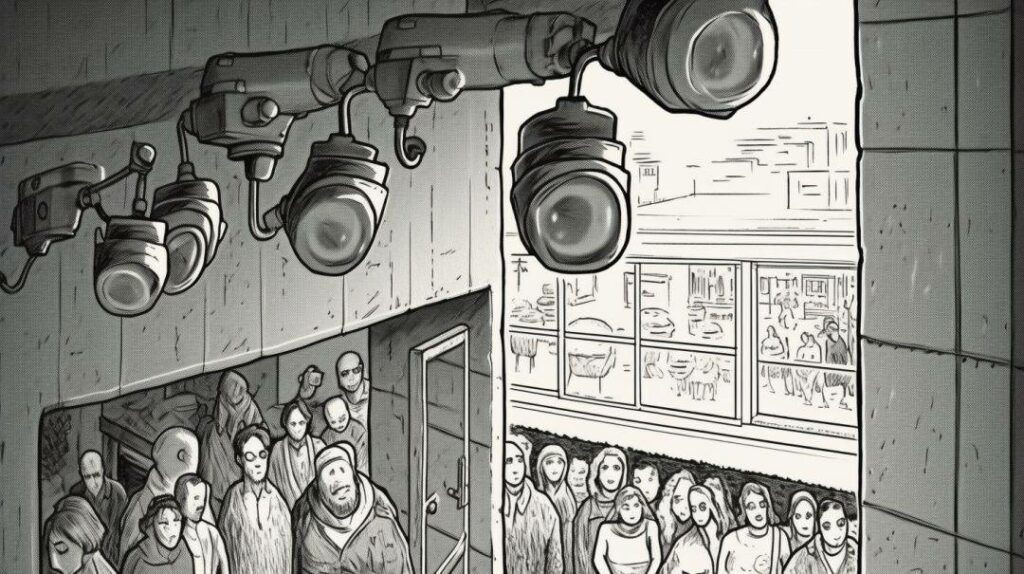
While CCTV systems offer significant security and safety benefits, utilizing cameras in schools also raises valid challenges and concerns that leaders must consider:
- Privacy and FERPA regulations – Cameras must be placed and operated appropriately to avoid violating student and staff privacy rights protected under the Family Educational Rights and Privacy Act (FERPA).
- Proper placement of cameras – Careful planning is required to ensure camera positioning optimally monitors security risks while minimizing unnecessary surveillance of sensitive areas.
- Camera visibility and effectiveness – Overt, highly visible security cameras provide the maximum deterrence, but covert cameras may better capture unfiltered behaviors.
Privacy and FERPA Considerations
One of the major considerations with school security cameras is the privacy of students and staff. The Family Educational Rights and Privacy Act (FERPA) protects the confidentiality of student records, including photos and videos. Schools must take care to place cameras only in common areas where people do not have a reasonable expectation of privacy, and to avoid capturing close-up identifiable images. FERPA compliant usage and storage of camera footage is essential.
Proper Placement is Crucial
The specific placement of security cameras requires careful planning and situational analysis. The goal is to position cameras to effectively monitor the most high-risk areas for security incidents, while minimizing coverage of spaces like bathrooms, locker rooms, private offices and classrooms where privacy is important. Documentation of camera locations is key.
Visibility and Effectiveness Can Conflict
Highly visible cameras provide the maximum deterrence value, but sometimes more discreet, hidden cameras may better capture unfiltered student behaviors to aid investigations. Schools must find the right balance for their specific context and objectives.
Best Practices for Implementing Security Cameras in Schools
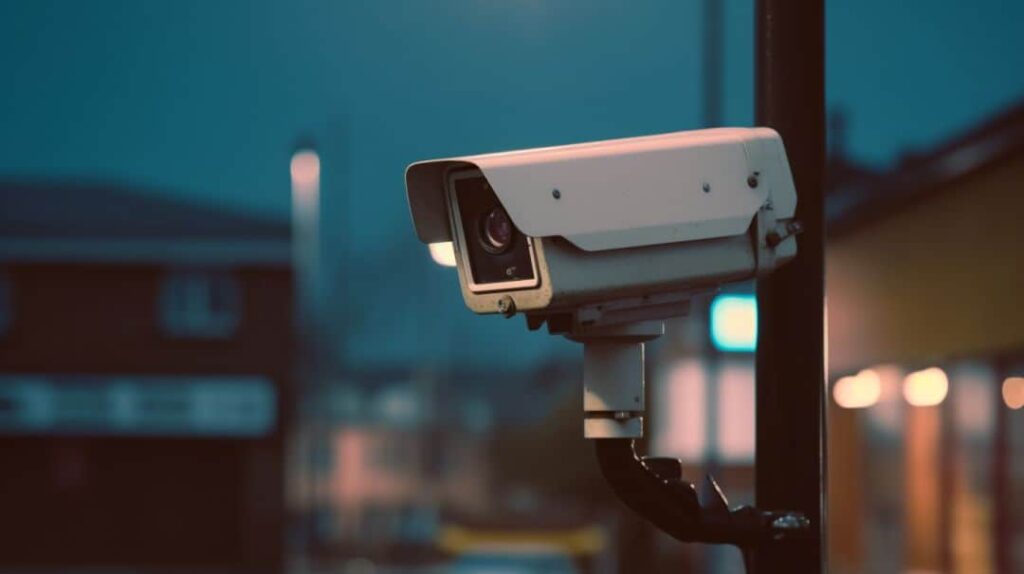
To maximize the benefits of CCTV systems while navigating valid privacy and operational concerns, schools should follow these best practices:
- Establish a clear policy and guidelines – Develop and communicate policies governing appropriate use of cameras, data access, monitoring, and retention of footage.
- Consult with school community members – Engage students, parents, staff, and community leaders to provide input on the CCTV security plan.
- Properly train staff on camera usage – Designate personnel to monitor feeds and provide comprehensive training on video surveillance responsibilities.
Create a Written CCTV Policy
Schools should have a well-documented CCTV surveillance policy detailing data access, monitoring procedures, video retention timelines, and appropriate vs. prohibited uses of footage. The policy development process can serve as an opportunity to engage the school community and address concerns upfront through collective problem solving.
Train Staff and Restrict Access
Only properly trained security personnel should actively monitor camera feeds, and access to footage should be limited. Staff with monitoring responsibilities need training on privacy rights, FERPA, and appropriate intervention protocols when concerning activities are observed.
Post Signage Announcing 24/7 Recording
Visible signage disclosing that CCTV monitoring and recording is underway helps reinforce deterrence, while also supporting consent requirements under certain state laws.
Innovative Uses of Security Cameras for Schools
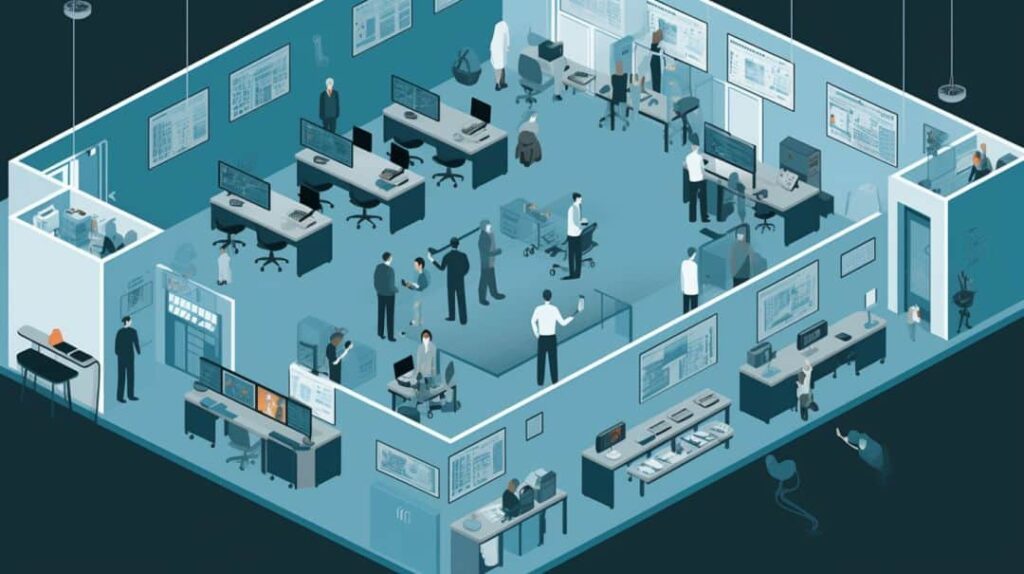
While the primary motive for school CCTV systems is enhancing student safety and security, camera capabilities can support many other innovative uses when properly leveraged.
Monitoring Social Distancing and Crowd Control
During infectious disease outbreaks like COVID-19, cameras with analytics can automatically monitor social distancing in common areas like hallways and cafeterias. School administrators can quickly identify problem areas and make adjustments to schedules or traffic flow to lower transmission risks.
Some systems even integrate with access control to restrict overcrowding. For example, camera analytics may temporarily lock certain doors if occupancy thresholds are exceeded in a space.
Tracking School Buses and Bus Stops
Student transportation is a major responsibility for schools. CCTV cameras on buses combined with GPS tracking provide live and historical insight into bus locations. School staff can remotely monitor behavior and incidents on bus routes.
Cameras at bus stops also enhance safety by allowing response to emergencies or delays. Intelligent analytics can even detect if students exit the bus at the correct stops.
Monitoring Access to Restricted Areas
Schools contain many areas with limited access such as science labs, computer rooms, medical facilities, maintenance areas and more. Integrated video surveillance and access control systems can help enforce access policies by visually verifying authorized entry into sensitive spaces.
Enhancing Fire Safety with Addressable Alarm Systems
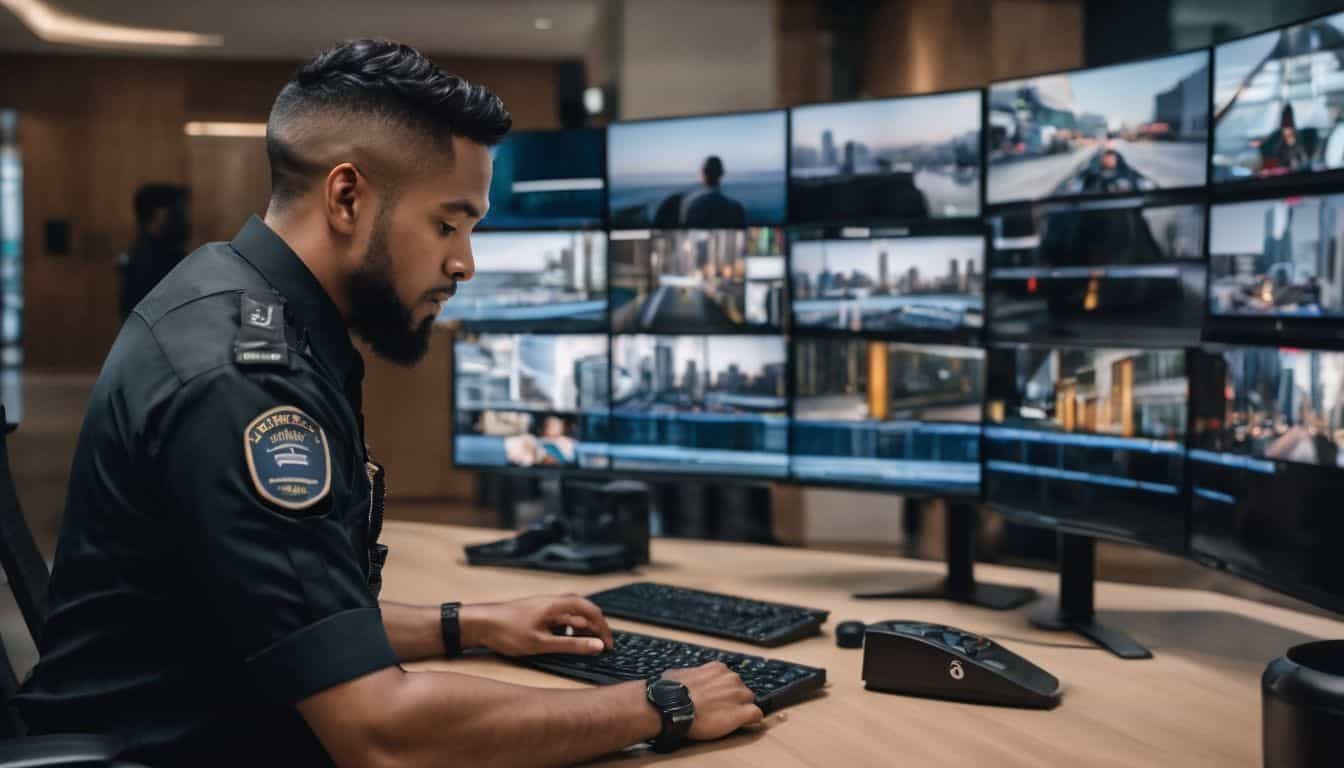
Addressable fire alarms direct integrate with IP cameras to instantly pull up live feeds from nearby cameras when a fire sensor is triggered. This helps staff rapidly locate and assess potential fires or false alarms. Some systems can even automatically steer pan-tilt-zoom cameras to view the alarm location.
Improving Campus Security with Access Control
When doors are equipped with networked access control, their systems can be unified with video surveillance under one platform. Administrators can manage door access permissions along with camera systems from one interface. Access door activity is automatically logged and can activate alerts if doors are forced open or used during unusual hours.
Analytics for People Counting, Dwell Time Monitoring
Camera-based analytics provide insightful data on school facility usage through anonymous people counting, dwell time monitoring, and traffic flow analysis. School leadership can leverage this information to optimize scheduling, room usage, hallway congestion, cafeteria occupancy, and more.
License Plate Recognition at Parking Lots
School parking lots and vehicle entryways are prime locations for vandalism, theft, prohibited parking, and unauthorized access outside of hours. License plate recognition (LPR) capabilities allow security teams to maintain databases of approved vehicle plates. LPR automatically checks each vehicle against the database and immediately alerts staff to any unauthorized vehicles.
Artificial Intelligence to Detect Weapons or Threats
One emerging innovation is artificial intelligence that can automatically detect weapons or aggressive behavior in surveillance footage without requiring constant human monitoring. While AI currently has limitations, this technology is rapidly advancing and could provide threat alerts to school security teams.
As camera hardware, video analytics, and AI capabilities continue to evolve, schools can find new ways to leverage their CCTV systems to protect students while creating an optimal learning environment. With a combination of technology and well-developed policies, CCTV can have a profoundly positive impact on modern educational institutions.
How Schools Can Benefit from Upgrading to Modern Security Cameras
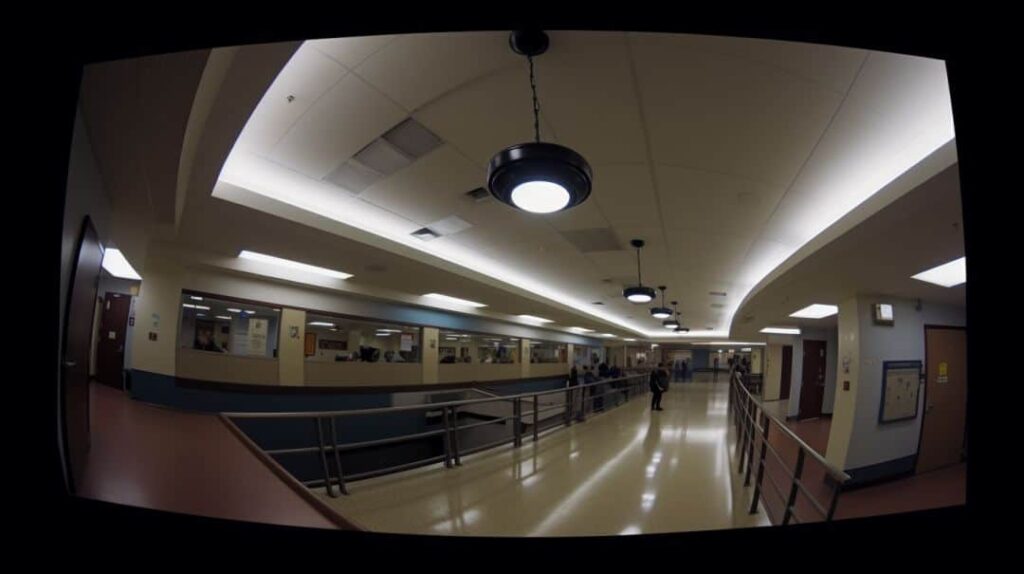
Many educational institutions still rely on outdated analog CCTV systems that are ineffective for today’s evolving security challenges. Upgrading to a modern, networked IP camera system provides significant benefits:
Improved Image Clarity
New 4K and 5MP camera resolutions provide pristine image quality compared to grainy analog video. Critical details like faces, license plates and textual evidence are clearly identifiable. H.265 video compression saves storage while preserving quality.
Easy Remote Access to Footage and Analytics
Authorized staff can conveniently access HD video and smart camera analytics from any web browser or mobile device. Modern systems make searching and exporting footage quick and easy for investigative purposes.
Smartphone Monitoring and Alerts
With mobile apps and remote access, principal and security teams can view live feeds from phones, receive push notifications if activity is detected, and respond faster to incidents.
Improved Physical Security
IP cameras have robust metal housing and ethernet cabling that is more tamper proof compared to analog coax cable. Built-in firmware encryption prevents video signal interception.
Scalability and Integration
Adding more IP cameras is plug-and-play, and systems easily integrate with other campus security solutions via API connectors and protocols like ONVIF. This flexibility streamlines upgrades.
By leveraging the latest camera technologies and remote management platforms, schools can significantly enhance video surveillance capabilities across districts. Consultation with a trusted security integrator ensures transitioning to an IP-based system is smooth and maximizes ROI.
Case Studies: School Districts Using Verkada Security Cameras
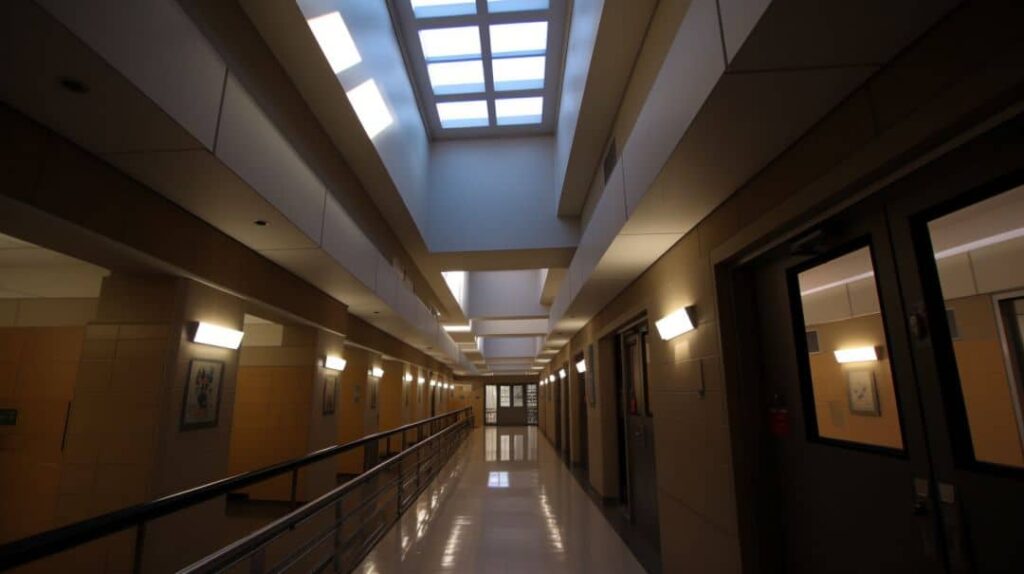
Many leading school districts across the United States have successfully deployed Verkada security cameras and experienced dramatically improved campus safety and security. Here are some real-world examples:
Newtown Public School District
The Newtown Public School District in Connecticut sought to enhance security after the tragic Sandy Hook Elementary shooting in 2012. They chose Verkada because its cloud-based system offered easy remote monitoring and scalability across 10 different facilities.
According to Newtown’s Director of Technology, Verkada delivered “light years of improvement” compared to their old analog system. Footage is now easily accessible from any device instead of requiring physical interaction with dated DVRs. The school has leveraged Verkada’s onboard storage and 10-year warranty to completely avoid the cost of buying and maintaining local NVR servers.
Most importantly, Newtown staff and students feel more protected with comprehensive video coverage across campus. Verkada cameras have even helped the transportation department investigate bus incidents and monitor stops.
Zionsville Schools
Indiana’s Zionsville Community Schools wanted to upgrade their failing camera system to improve visibility across 5 elementary schools, a middle school and high school. After evaluating options, Zionsville selected Verkada because it offered easy centralized management and scalability.
According to Zionsville’s Director of Technology, the Verkada system “paid for itself instantly” by resolving long-standing blind spots in coverage while delivering reliable performance. Authorized staff appreciate the ability to conveniently access footage from any device through mobile apps or web browsers.
Ongoing costs are minimal thanks to Verkada’s inclusive 10-year warranty. The district anticipates expanding their 190+ camera network as they upgrade more facilities.
Steamboat Springs School District
With dated analog cameras nearing end-of-life, Steamboat Springs School District in Colorado sought an enterprise-level IP video solution. After comparing options, Steamboat Springs chose Verkada for its hassle-free cameras with 10-year onboard storage and hardware warranty included.
The Facilities Director reported dramatically clearer image quality with Verkada, eliminating the pixelated footage they struggled with previously. Remote access allows staff to monitor events live from computers or smartphones. For a district with 10 different facilities across 42 square miles, Verkada’s centralized management platform also saves huge time and effort compared to their old locally managed DVRs.
By partnering with Verkada, Steamboat Springs modernized video security across their campuses while simplifying operations and management.
Leverage Verkada’s Cloud-Based Simplicity
Like these leading school districts, all educational institutions can benefit from Verkada’s industry-leading cloud-based security camera solution. Verkada minimizes complexity by combining high-quality hardware with an intuitive software platform for unparalleled scalability, ease of use, and TCO savings.
To learn more about Verkada’s video security offerings for education, contact Jefferson Security today for a free consultation and quote. Investing in campus-wide IP surveillance delivers long-term dividends through enhanced security, lower liability risks, and peace of mind across school communities.
Conclusion: Why Schools Should Consider Utilizing Security Cameras

In today’s world, security cameras have become an essential component of a comprehensive strategy to protect students, faculty, and facilities at educational institutions. As threats persist, technology advances allow CCTV systems to become increasingly intelligent, scalable, and easy to manage.
Deployed properly following key best practices, video surveillance offers invaluable benefits:
- Enhanced safety and security – Proactive monitoring helps quickly detect threats and expedite emergency response
- Situational awareness – Live and recorded video provides invaluable insights during investigations
- Deterrence – Visible cameras and signage dissuade criminal or policy violating behaviors
- Remote accessibility – Admins and security teams can instantly access video from any device
- Scalability – Networked systems allow easy expansion across large campuses
- Operational optimization – Video analytics provides data to improve facility usage efficiency
- Liability protection – Comprehensive footage protects schools against fraudulent claims
- Community assurance – Students, parents and staff appreciate the extra layer of protection
While student privacy must stay at the forefront, advanced CCTV technologies allow schools to reap these benefits while responsibly minimizing risks through proper policies, positioning, and usage.
Ultimately, specifying high-quality 21st century video surveillance is one of the wisest investments educational institutions can make to foster positive, welcoming, and secure learning environments where students can thrive. Administrators with questions are encouraged to contact video security experts at Jefferson Security for a free consultation and system assessment.
FAQs
What types of security cameras are best for schools?
The most common security cameras utilized in educational institutions are fixed position cameras such as bullet cameras and vandal-resistant dome cameras. For large open areas, Pan-Tilt-Zoom (PTZ) cameras allow remote directing and zooming of the camera. Small compact cameras can also be used in classrooms and offices where overt surveillance is less desirable.
Where should security cameras be installed in schools?
Cameras should be installed in high-traffic areas prone to incidents like building entrances, parking lots, cafeterias, hallways, and common areas. Cameras are generally avoided in private spaces like locker rooms, bathrooms and private offices. Exterior coverage of access points is key.
How does video surveillance improve school security?
Video cameras enhance security by providing 24/7 monitoring of campus activities and early detection of suspicious individuals or dangerous behaviors. Footage aids investigations while deterring future misconduct through improved accountability. Rapid access to video allows quicker response by administrators and law enforcement.
What are some innovative uses for security cameras in education?
Beyond basic monitoring, some innovative uses of video surveillance include tracking school bus locations, enforcing social distancing, controlling building access, detecting weapons, monitoring restricted areas, integrating with other systems like fire alarms and access control, and analyzing facility usage with analytics.
How can schools balance student privacy with security cameras?
Schools should have clear CCTV policies governing where cameras are placed, video retention, who can access footage, and appropriate vs prohibited uses. Keep cameras in common areas, post signage about surveillance, train staff on proper practices, and ensure compliance with student privacy laws like FERPA.
